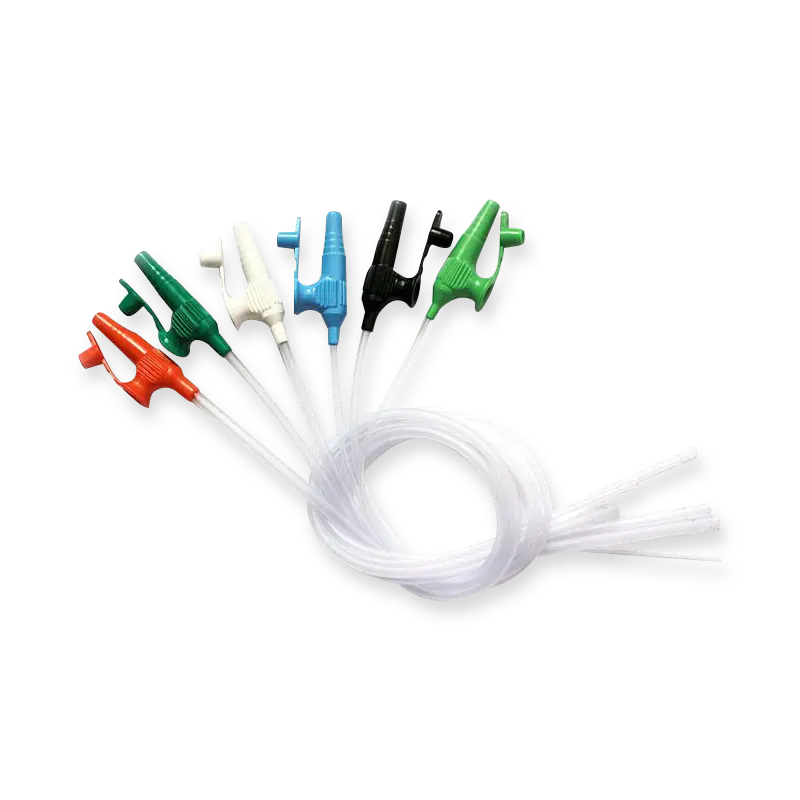Suction catheters are an important device in various healthcare settings, allowing for the effective removal of secretions from the patient's airways. Learning the proper use of suction catheters is crucial for ensuring patient safety and comfort. This article shares use steps and 6 considerations for using suction catheters, now have a quick look. Steps for Using a Suction Catheter 1. Preparation and Equipment Gathering Start by gathering all vital supplies, including gloves, a suction machine, sterile saline, and the suction catheter. Ensuring you have a suction catheter kit ready will streamline the process and enhance efficiency. Perform hand hygiene and wear gloves to preserve a sterile environment. 2. Setting Up the Suction Device Connect the suction catheter to the suction machine, ensuring that the correct suction pressure is set. For adults, the recommended pressure typically ranges from 80 to 120 mmHg. For pediatric patients, it is significant to lower the pressure to maintain a strategic distance from injury. 3. Pre-Oxygenation Before inserting the catheter, pre-oxygenate the persistent to moderate desaturation, particularly in patients at risk for respiratory compromise. Usually imperative to keep up satisfactory oxygen levels amid the procedure. 4. Inserting the Catheter Delicately embed the suction catheter into the aviation route, taking care to maintain a strategic distance from the over-the-top drive. Suctioning ought to be as it happened while pulling back the catheter to play down bothering and injury to the airway. 5. Monitoring Patient Response After suctioning, assess the patient's response and monitor oxygen immersion levels. Continuous observation amid and after the strategy is essential for ensuring patient safety and comfort. Post-Use Care and Maintenance After successfully using the suction catheter, follow these steps for proper disposal and documentation: Disposal: Dispose of the suction catheter according to medical waste protocols. Most suction catheters are designed for single use to ensure sterility and safety. Documentation: Record the procedure in the patient's medical record, noting the type and amount of secretions removed, as well as the patient's response. This information is vital for ongoing patient management. Key Considerations for Effective Suctioning Frequency of Suctioning Suctioning should only be performed as needed. Routine suctioning can pose risks, including airway irritation and hypoxia. Monitor the patient's condition closely to determine the appropriate frequency. Catheter Size Selection The size of the suction catheter should be suitable for the patient's age and airway anatomy. Pediatric patients require smaller catheters, generally ranging from 6 to 8 French, while adults may need sizes from 10 to 14 French. The catheter should ideally occupy less than 50% of the inner breadth of the airway tube to avoid obstruction. Vacuum Pressure Levels Utilize a vacuum pressure level of 70 to 150 mmHg for adults, altering as fundamental based on the consistency of secretions. Higher pressures may be fitting for thick secretions but can increase the risk of mucosal injury. Open vs. Closed Suctioning Systems Open suctioning temporarily disconnects the patient from the ventilator, while closed systems allow the patient to remain connected. Each method has its advantages, and the choice should be based on the clinical situation and patient tolerance. Depth of Catheter Insertion The depth of insertion can vary; some practitioners favor deep suctioning to clear lower airway secretions, while others advocate for shallow suctioning to minimize the risk of trauma. Monitoring and Clinical Judgment Regularly assess the patient's condition and adjust the suction catheter size as needed. Monitoring the patient's response during suctioning is crucial to ensure safety and effectiveness. Conclusion Using suction catheters successfully is vital for healthcare professionals included in airway management. BEVER Medical offers a comprehensive range of suction catheters and suction catheter kits appropriate for children, adults, and the elderly. By following appropriate tips and guidelines, healthcare providers can upgrade patient outcomes and ensure safer, more efficient care. For more information on our suction catheter products, please visit Bever Medical. They can meet your clinical needs, browse more on our website can help you make informed decisions.
View More +-
01 Apr 2025
Urinary incontinence is a common health problem for humans that seriously affects people's lives and work, so many people are reluctant to discuss it. For women, sometimes they face menstruation, which can bother them. Therefore, managing urinary incontinence is important. However, it may be a big challenge for novices. Luckily, it will be simple here. This article provides some care guidelines for women with urinary incontinence. Check it out now. Use urinary continence care products Urinary continence care products are designed to help women effectively manage urinary incontinence in their daily lives. These items include catheters, absorbent pads, liners, and specially designed underwear that can quickly absorb leaked urine, keep the skin dry, and avoid disturbance and contamination. Catheter Supplies For female patients who cannot totally purge their bladders, health specialists will suggest the use of female catheters according to the patient's physical condition. These catheters are appropriate for the female body structure and allow self-intermittent catheterization to help purge the bladder and avoid urinary tract infections and other complications. When choosing, the doctor will help select the correct size and length and usually recommends the use of disposable catheters. It makes a difference to encourage substitution amid daily life and travel. Absorbent pads Absorbent pads are large-area protective products that are often used on beds or chairs to prevent urine from leaking onto furniture. They are highly absorbent and often come with a waterproof backing to ensure that liquids do not penetrate the surface underneath. Patients can purchase them in the amount of absorbency they need. Liners Pads are a lighter incontinence care product for women with mild to moderate incontinence. Similar in shape to feminine hygiene pads, but with a higher absorbency, they quickly absorb urine and lock in moisture, reducing odor and keeping the skin dry. Patients can choose the appropriate absorbency level based on their daytime and nighttime needs. Specially designed undergarments Specially designed incontinence undergarments look like regular underwear but have built-in absorbent layers and waterproof barriers to effectively absorb urine while remaining breathable and comfortable. Specially designed undergarments are better suited to women who want to maintain privacy and a normal lifestyle than traditional liners and absorbent pads. Dietary help for female incontinence Avoid bladder irritants by including non-acidic fruits, fiber-rich foods, and hydrating vegetables in your diet. Eating certain foods can improve bladder health, while other foods may worsen symptoms. Fiber-rich fruits such as bananas, blueberries, pears, and watermelon can prevent constipation and relieve pressure on the bladder. However, oranges are high in acidity, which can irritate the bladder. Vegetables such as asparagus, carrots, lettuce, and bell peppers are rich in vitamins and minerals that benefit overall health. Other important dietary tips: Increase your fiber intake: High-fiber foods can help prevent constipation, which can indirectly reduce the occurrence of urinary incontinence. Stay hydrated: Drink 6 to 8 glasses of water a day and avoid overactive bladders. Limit caffeine and alcohol: These drinks may irritate the bladder and increase urination frequency and urgency. Exercises to Help Women with Urinary Incontinence Performing specific exercises regularly can strengthen the pelvic floor muscles and improve urinary incontinence symptoms. Kegel exercises are the most commonly recommended and help strengthen the muscles that control urination. Kegel Exercise Guide: 1. Identify the pelvic floor muscles: Try to stop mid-urination to find the correct muscle group. 2. Practice contractions: Tighten your pelvic floor muscles, hold for 2 seconds, then relax. 3. Repeat: Perform 3 sets of 10 contractions daily, gradually increasing the hold time to 10 seconds. Exercise Tips: Avoid high-impact activities: These activities you shouldn't do, such as running and jumping, which may increase abdominal pressure and worsen incontinence. Consider Pilates or yoga: Do low-impact exercises to help strengthen the core and pelvic floor muscles. Comprehensive Management and Professional Support In addition to the above ways, lifestyle adjustments and looking for professional assistance are equally important. Regular urination, avoiding weightlifting, stopping smoking, controlling weight, and promptly treating obstruction can all help improve urinary incontinence symptoms. If self-management is ineffectual, it is suggested to consult a healthcare proficient to explore other treatment options, such as medication or surgery. Conclusion Master the above strategies to manage female urinary incontinence to enhance the quality of daily life. Urinary incontinence can be securely and viably controlled by combining the utilization of suitable continence care products, dietary adjustments, regular exercise, and way-of-life changes. For more professional catheter supplies, it would be ideal if you view the BEVER Medical website.
View More + -
28 Mar 2025
Suction catheters ensure patients breathe smoothly, they are vital medical devices used in hospitals, emergency care, ICUs, long-term care facilities, and home care. In case patients experience respiratory issues or require airway management, suction catheters can make a great difference. As the global aging population grows and chronic respiratory diseases become more common, the demand for suction catheters continues to rise. This article explores the applications and market trends of suction catheters, providing insights and tips for catheter suppliers. What Is a Suction Catheter? A suction catheter is a medical device used to remove secretions from a patient's airway through negative pressure suction. Different designs and applications have led to several types of suction catheters: Standard Suction Catheter It is the most common type used for routine suctioning. Generally, it is made from PVC or other durable materials, it is simple to use and widely applied in hospitals, emergency care, and ICUs to effectively clear airway secretions. Soft Suction Catheter As the name shows, it is made of flexible materials, ideal for sensitive patients or long-term use. Children have narrower and more delicate airways and elderly patients often suffer from chronic conditions. Soft suction catheters help minimize airway irritation. Wide Applications of Suction Catheters Pediatric Care Children's airways are smaller and more sensitive, requiring softer, thinner suction catheters. Doctors often use silicone soft suction catheters to reduce irritation. Adult Care While adults have wider airways, comfort remains important. Standard suction catheters made from PVC or silicone balance cost and performance. Elderly Care Older patients often have chronic respiratory diseases and require frequent suctioning. Silicone directional tip suction catheters improve efficiency and reduce discomfort. Emergency and Critical Care Quick and effective airway clearance is crucial. PVC standard suction catheters are economical, practical, and easy to use. Market Growth Drivers Aging Population The number of people aged 60 and above is expected to reach 2 billion by 2050. Chronic respiratory diseases like COPD and asthma are common among the elderly, leading to a rising demand for suction catheters. Older patients often require long-term airway management, making suction catheters essential for improving their quality of life. Healthcare Expansion to Rural Areas Governments are encouraging the development of primary healthcare facilities such as township hospitals and community clinics to improve accessibility and fairness in healthcare services. These institutions are adopting high-quality suction catheters to enhance treatment outcomes and patient satisfaction. As primary healthcare improves, suction catheter demand will continue to grow. Growing Home Care Market With more patients getting treatment at home, the request for home medical equipment, including suction catheters, is increasing. Many elderly and chronic disease patients rely on home-based care, making suction catheters a convenient solution. The rise of home care also encourages product innovation to meet different patient needs, further driving market growth. Conclusion As the global aging population increases and respiratory diseases become more predominant, the request for suction catheters will proceed to develop. Suction catheter producers can seize this opportunity to deliver diverse sorts of suction catheters to meet different needs. In the future, increasingly individuals will pay consideration to home care, encouraging the growth of the suction catheter market. If you need to know more about suction catheters or discover high-quality therapeutic gear, welcome to contact Bever Medical, we are committed to giving you the finest suction catheter solutions.
View More + -
21 Mar 2025
In medical care, suction catheters are essential devices for clearing airway discharges or liquids, keeping patients able to breathe smoothly. There are several different types of suction catheters, including suction catheters with control valves, PVC suction catheters, and soft suction catheters. In this article, we will talk about them and provide a guide on how to choose. What is a Suction Catheter? A suction catheter is a medical device utilized to expel emissions, fluids, or other obstructions from a patient's airway, guaranteeing clear breathing. These catheters are broadly utilized in hospitals, emergency care, operating rooms, and domestic care settings, especially for patients with breathing challenges, airway blockages, or those requiring post-surgical care. There are a few sorts of suction catheters accessible, each with interesting materials, highlights, and applications. Underneath are the major common types: Suction Catheter with Control Valve A suction catheter with a control valve is an advanced version equipped with a regulation mechanism, allowing precise control over suction pressure. The main advantages include: Precise suction control: Healthcare professionals can adjust suction intensity according to patient needs, reducing airway damage and discomfort. Enhanced safety: Prevents excessive suction that may cause mucosal damage. Easy operation: Single-hand control simplifies handling and improves efficiency in medical procedures. Applications Intensive Care Units (ICU) and operating rooms where precise suction control is required. Pediatric, neonatal, and elderly patients with delicate airways. Patients requiring long-term airway management, such as those with endotracheal or tracheostomy tubes. PVC Suction Catheter PVC suction catheters are the most commonly used type, made from polyvinyl chloride (PVC), offering the following benefits: Cost-effective: More affordable compared to silicone or soft-material catheters. High durability: Strong and flexible material, resistant to breakage and deformation, making it ideal for frequent use in hospitals. Wide compatibility: Suitable for most suction devices, commonly used in hospitals, home care, and emergency situations. Applications Routine hospital care for respiratory patients. Emergencies requiring quick airway clearance. Long-term home care for patients with chronic obstructive pulmonary disease (COPD). As a PVC suction catheter manufacturer, Bever Medical provides high-quality PVC suction catheters that meet international medical standards and are widely used in healthcare institutions. We offer various specifications to meet different patient needs. Soft Suction Catheter Soft suction catheters, typically made from silicone or specialized flexible materials, are designed to enhance patient comfort. Features Soft material: Minimizes airway damage, making it suitable for sensitive patients. Reduced discomfort: Ideal for prolonged use, especially for bedridden or tracheostomized patients. High biocompatibility: Latex-free silicone material reduces allergy risks, making it safe for patients with allergic conditions. Applications Post-surgical patients requiring gentle airway management. Pediatric, elderly, or sensitive patients who experience discomfort with rigid catheters. Long-term suction care for chronic disease patients. Bever Medical offers soft suction catheters with medical-grade silicone and PVC, ensuring superior comfort and safety. All products meet international medical standards and undergo rigorous quality control. How to Choose the Right Suction Catheter? When choosing a suction catheter, a few key components ought to be considered. A suction catheter with a control valve permits flexible suction, making it perfect for situations that require exact control, such as ICUs and pediatric care. Be that as it may, it tends to be more costly. PVC suction catheters, on the other hand, are cost-effective and broadly utilized for common care, even though they offer settled suction levels and standard quiet comfort. For those requiring long-term care or a gentler touch, delicate suction catheters made from silicone give tall consolation and are reasonable for touchy patients, even though they come at a marginally higher cost than PVC alternatives. Conclusion Suction catheters play a significant part in medical care, and selecting the right type is basic for patient comfort and treatment effectiveness. Whether it’s a suction catheter with a control valve, a PVC suction catheter, or a soft suction catheter, each type has its advantages suited for different medical situations and patient needs. As a reliable manufacturer, Bever Medical offers high-quality suction catheter products that cater to hospitals, healthcare institutions, and medical procurement experts. For more information, please feel free to contact us!
View More + -
05 Mar 2025
Suction catheters are suitable for different therapeutic scenarios and play a vital role in keeping the airway clear in basic minutes. Whether in a healing center, rescue vehicle, or domestic care environment, these basic however capable instruments offer assistance clear aviation routes and avoid complications. Therefore, they are considered one of the most common and valuable devices in a therapeutic supply kit. In this article, we are going to talk about 11 key uses of suction catheters. Now, let's get started! 1. Clearing the Mouth and Throat Suction catheters are primarily utilized to clear discharges, blood or upchuck from the mouth and throat to avoid suffocation. In patients after surgery, amid the recuperation period of anesthesia, or in patients with impeded gulping work due to illness, suction catheters can successfully expel fluid and strong buildups that will square the airway. Due to its delicate nature, delicate suction catheters can decrease disturbance to verbal and throat tissues and give a gentler care experience. 2. Keeping Airways Clear Suction catheters are a vital apparatus for clearing the airway and lessening the risk of suffocation when the patient's airway is blocked by bodily fluid or remote objects. Whether within the healing center, domestic care or crisis scene, restorative staff can rapidly utilize suction catheters to assist patients continue ordinary breathing. Delicate suction catheters can enter deeply into the airway, minimizing harm and inconvenience, particularly for patients with limited or sensitive airways. 3. For Intubated Patients Patients with tracheal intubation or tracheostomy are at risk of secretion accumulation due to their limited ability to expectorate. Suction catheters help prevent infections and breathing difficulties. Soft suction catheters are ideal for long-term intubation, reducing tissue damage and complications. 4. Post-Surgery and Anesthesia Care After surgery or during general anesthesia, patients may experience obstruction due to increased airway secretions. Suction catheters can clear these secretions in time to ensure that patients can breathe smoothly. Especially after complex surgery or long-term anesthesia, the use of soft suction catheters can reduce irritation and reduce patient discomfort. 5. Dental Procedures In dental surgeries, suction catheters remove blood, saliva, and other fluids to maintain a clear surgical field and improve precision. Dentists use them during root canals, extractions, and other procedures to keep the mouth clean and prevent patients from swallowing blood or debris. 6. ICU and Critical Care In intensive care units (ICU), mechanically ventilated patients require regular airway suctioning to reduce infection risk and improve breathing. Suction catheters remove accumulated mucus, preventing pneumonia and other complications. Soft catheters reduce airway damage and discomfort. 7. Emergency and Pre-Hospital Care In emergencies like trauma or choking incidents, suction catheters quickly clear airways, increasing survival chances. They are essential in ambulances to stabilize patients before reaching the hospital. The flexibility of soft suction catheters makes them easy to use for all age groups. 8. Pediatric and Neonatal Care Newborns and infants have small airways prone to blockage by secretions. Suction catheters effectively clear nasal and oral passages, making them ideal for neonatal intensive care (NICU) and pediatric settings. Soft suction catheters prevent injury to delicate tissues. 9. Diagnostic Assistance Suction catheters are also used to collect samples such as sputum or saliva for laboratory analysis. They help diagnose infections, pneumonia, and other respiratory conditions by providing accurate specimens for testing. 10. Long-Term Patient Care For bedridden patients, including the elderly and those with chronic respiratory conditions, suction catheters prevent secretion buildup, reducing the risk of aspiration pneumonia and improving overall care. Soft suction catheters offer a more comfortable experience. 11. Preventive Use for High-Risk Patients For patients with rest apnea, corpulence or other high-risk airway conditions, customary use of suction catheters can decrease the hazard of sudden airway obstruction. These patients may be inclined to breathing issues due to excessive bodily fluid discharge or muscle unwinding, and the use of suction catheters can effectively avoid potential perils and guarantee their security. Choosing the Right Suction Catheter Suction catheters are basic in therapeutic care, especially soft suction catheters, which offer adaptability and consolation for newborns, elderly people, and intubated patients. If you're seeking high-quality suction catheters, Bever Medical provides a wide range of reliable products to meet diverse care needs. Contact us today for more solutions and give the leading care for your patients!
View More + -
20 Feb 2025
Every parent faces the challenge of a baby with phlegm, especially during flu season. For new parents, this may make them feel overwhelmed. However, if parents know what baby suctioning is and the common causes of phlegm will ease such a situation. This guide will help you learn how to safely and effectively help your baby clear mucus, whether suctioning is necessary, and how to care for your baby at home. We believe you can ease your worries and help your little one recover faster with the right approach. Without further ado, let's have a quick look now! What Is Baby Suctioning? Baby suctioning involves a suction catheter (usually a soft suction catheter). It helps remove mucus and secretions from the nose and throat. Since infants have weak cough reflexes and cannot clear mucus themselves, excess mucus can lead to choking, nasal congestion, and feeding or sleeping difficulties. So, it's important to adopt proper suctioning, which helps clear the airways and makes breathing easier. Suction catheters for newborn children are lean and work with moo suction weight, minimizing hurt to sensitive nasal and throat tissues. Whereas the method may seem awkward, it is by and large well endured by babies. In case you're searching for a safe and high-quality suction catheter for therapeutic utilize, Bever Medical could be a trusted choice for healthcare facilities. Common Causes of Excess Mucus in Babies The bodily fluid may be a typical emission from the respiratory tract, making a difference trap and expel tidy, microscopic organisms, and infections. Beneath ordinary conditions, it clears actually through hacking. Be that as it may, when over the top or as well thick, it can square aviation routes and make breathing troublesome. Since a baby's aviation route is much smaller than an adult's, indeed a little sum of bodily fluid can cause blockage. Common causes include: Infections: Colds, flu, bronchitis, and pneumonia can trigger excessive mucus production. Allergies: Exposure to pollen, dust mites, or pet dander can cause airway inflammation, leading to more mucus. Dry air: Low humidity can thicken mucus, making it harder to clear. Irritants: Secondhand smoke, dust, and strong chemicals can increase mucus production. When Is Suctioning Necessary? Suctioning is as it were required when bodily fluid seriously squares the aviation route and causes trouble breathing. On the off chance that done inaccurately or as well regularly, it can harm sensitive tissues. When Need to Suctioning: Newborns with fluid blockage: Doctors may suction newborns who have residual amniotic fluid or meconium in their airways. Severe congestion: If your baby is struggling to breathe, turning blue, or wheezing severely, suctioning may be necessary. Respiratory illnesses: In cases of pneumonia or bronchitis, suctioning might be required under medical supervision. Risks of Suctioning Incorrect or frequent suctioning can cause: Mucosal damage: Overuse can irritate or even injure the airway lining. Increased discomfort: Some babies may experience throat spasms, making breathing more difficult. Dependency: Relying too much on suctioning may weaken a baby's natural ability to clear mucus. How to Suction Mucus Safely If suctioning is necessary, follow these steps to reduce risks: Use a disposable baby suction device to prevent infection. Apply gentle suction to avoid damaging the airway. Suction before feeding to prevent vomiting. Limit suctioning frequency and consult a doctor if unsure. How to Help Your Baby Naturally Clear Mucus For most cases of mild congestion, home care is the safest and most effective approach. Here are some simple methods to help your baby clear mucus naturally: 1. Gentle Back Tapping (Percussion Therapy) This method helps loosen mucus in the airways, making it easier to cough up. How to do it correctly: Lay your baby on their side or stomach across your lap, with their head slightly lower than their body. Cup your hand (not a fist) and gently tap their back. Work from the lower back upward, repeating for 3-5 minutes, 2-3 times a day. 2. Increase Air Humidity Moist air helps loosen mucus, making it easier to clear. Use a humidifier: Maintain indoor humidity at 40%-60%. Steam therapy: Sit in a steamy bathroom with your baby for a few minutes to help loosen mucus. 3. Offer More Fluids (For Babies 6+ Months) Hydration thins mucus, making it easier to clear. Babies under six months should get fluids from breastmilk or formula only. 4. Keep the Nose Clear If nasal congestion is severe, use saline drops to loosen mucus before suctioning with a bulb syringe. When to See a Doctor Seek medical attention if your baby shows any of the following signs: Rapid or labored breathing (more than 60 breaths per minute or severe wheezing). Bluish lips or face, which indicate oxygen deprivation. High fever that doesn’t go away, suggesting a bacterial infection. Loss of appetite or lethargy. Persistent coughing for over a week could signal bronchitis or pneumonia. Conclusion It is common for babies to have a lot of sputum, and parents do not need to be overly anxious. Calm down and know the situation. In general, you can help your baby to expectorate naturally by patting his back, increasing air humidity, and feeding more water. If the sputum blockage seriously affects breathing, please suction appropriately under the guidance of a doctor. Parents should closely observe the changes in the baby's condition. If there are dangerous signs such as shortness of breath and purple face, you need to ask doctors for help in time to ensure the baby's safety.
View More +








